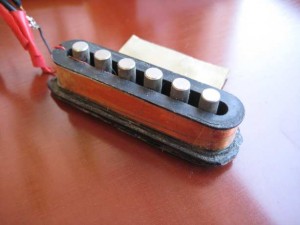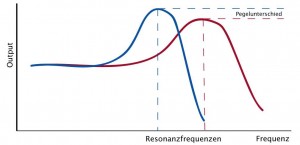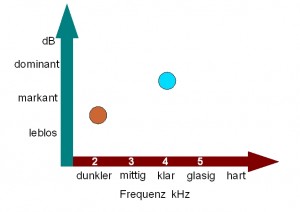Ordinary guitar pickups
What are the things under the guitar strings really for ?
These things – or ‘pickups’ – are the difference between an ordinary acoustic guitar and an electric guitar.
Why is that ?
Our effect-pedals need signal voltage.
The guitar amplifier will amplify a signal voltage. It’s this voltage that the pickups on the electric guitar supply to the following equipment.
Electric guitar pickups only work if metal guitar strings are vibrating over them.
While nylon strings do indeed sound good and play well, they can’t generate a voltage for the pickups on the electric guitar.
How do guitar pickups work?
A pickup is basically a wire coil that has been wound around several magnets.
When something metallic moves over the pickups, a (very weak) voltage will be inducted (generated by it).
This small voltage is our signal voltage.
Just as every microphone or loudspeaker produces a different sound, each guitar pickup sounds different. How the guitar pickup actually sounds is dependent on the design / constructions (number of rounds the wire has been wound around the magnets) and the materials used (wire diameter, magnet placement and specifications).
The picture below depicts a typical, simplified transient response of two guitar pickups.
What does this picture tell us ?
The horizontal line shows the increase in frequency – left the basses, right the trebles.
The vertical line shows the output and signal level of the pickups at the respective frequencies.
We can see that at low frequencies the signal output of both pickups is about equal.
At higher frequencies, the output level of the blue pickup starts to increase at a certain point, while the red pickup starts to increase its output at a much higher frequency point.
The peak of the curves represent the resonance frequency of the corresponding pickup.
The level of output signal increase at a resonance frequency is distinctly varied between each pickup, and the pitch of the resonance frequency is different in each pickup.
Both of the pickups whose data is displayed in the graph above will sound very different !
Imagine you play music through a 24-band EQ and dial in a bump somewhere in the lower frequencies and then, later, further above. It will sound utterly different.
A pickup with a strong and distinct increase of signal output at its resonance frequency will produce a very characteristic sound.
Guitar pickups will usually have their resonance frequencies between 2kHz and 5kHz.
Some pickups will produce a quite large resonant peak while other pickups will produce almost none.
The diagram below should clearly show the effects of both factors (frequency and height of resonance peak).
The red dot could be a Gibson Humbucker (weak resonance increase and rather far into the bass section).
The blue dot corresponds to data collected from something like a Fender pickup (higher resonance increase and further over; in the higher section).
It is the experience and the ability of the pickup’s manufacture to define the sound a pickup produces. It is the choice of materials and the construction of the pickups which allows them to produce a specific sound.
But let us not deceive ourselves.
Often, existing designs will be copied 100%. The magnet specification must be 100% the same as they were in 1956, the wire must have the same diameter and the lacquer, used to insulate the coil wire, must come out of a container found in Leo Fender’s basement.
I think the guys in the old days often just took what was available at the time and was therefore favorable.
However, the first pickup models have shaped our listening habits, and as a result, those sounds are always asked for and desirable.
The question often becomes : who does the job copying the old pickups the best?




Recent Comments